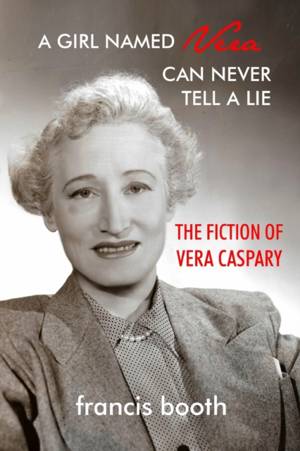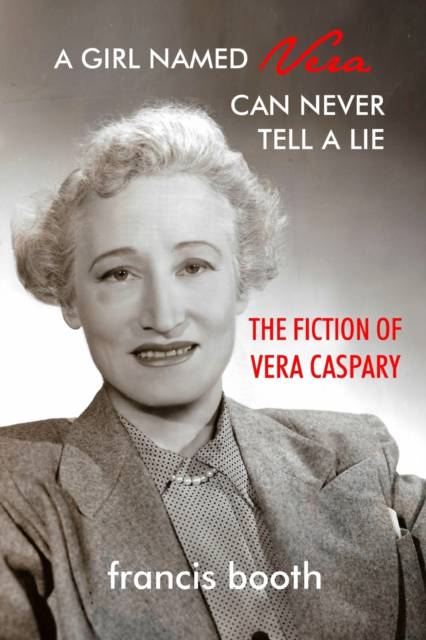
- Retrait gratuit dans votre magasin Club
- 7.000.000 titres dans notre catalogue
- Payer en toute sécurité
- Toujours un magasin près de chez vous
- Retrait gratuit dans votre magasin Club
- 7.000.0000 titres dans notre catalogue
- Payer en toute sécurité
- Toujours un magasin près de chez vous
A Girl Named Vera Can Never Tell a Lie
The Fiction of Vera Caspary
Francis Booth
Livre broché | Anglais
25,45 €
+ 50 points
Description
Vera Caspary (1899 - 1987) was ahead of her time but is perfectly aligned with ours. Caspary put strong, independent women at the center of over twenty novels, while tackling sexism, racism, fascism and antisemitism head on in both her life and her work; in the 1940s J. Edgar Hoover personally initiated an FBI investigation of her.
In the 21st century Caspary's novels have been republished by The Murder Room and The Feminist Press, showing the range of her writing and the breadth of her appeal.
Caspary's first published novel, The White Girl, 1929, concerns a young Black woman passes as white, very much akin to Nella Larsen's Passing, which came out later the same year. A 1930s family saga explored the Jewish experience in America. Then in 1942 Caspary turned the hard-boiled murder mystery inside out with Laura, putting a woman at its heart rather than the usual male detective and inventing the genre of the psycho-thriller. Laura was made into a highly successful film, as was its successor Bedelia, 1945, about "the wickedest woman who ever loved." Fritz Lang's great film noir The Blue Gardenia, 1953, was adapted from a Caspary novella. In the 1960s Caspary followed a gentle satire on sex in the suburbs with a searing Holocaust novel and then a "confession disguised as a novel" about communism in Connecticut; the final novels of the 1970s all explore the mystery of individual identity.
She made her living writing frothy, romantic stories and scripts for Hollywood movies and several of her novels were republished as lurid pulp paperbacks but at heart Vera Caspary was a connoisseur of classic British literature. One Caspary woman calls herself Haworth after the Brontë Parsonage and another is named Elaine after Tennyson's Idylls, while Stranger Than Truth pays homage to Wilkie Collins' The Woman in White and Bedelia echoes Mary Elizabeth Braddon's Lady Audley's Secret. In False Face, Nina was "weaned on Browning and Keats, taught to use my eyes in Florence," and in The Dreamers Ernestine plans a Ph.D. on George Eliot.
A Girl Named Vera Can Never Tell a Lie is a monumental and ground-breaking study, examining all of Caspary's published fiction, setting her in the context of her contemporaries and celebrating the Caspary woman, a heroine for our time.
Francis Booth is also the author of Amongst Those Left: The British Experimental Novel 1940 - 1980 Comrades in Art: Revolutionary Art in America 1926 - 1938 Maurice Maeterlinck: The Marionette Plays Everybody I Can Think Of Ever: Meetings that Made the Avant Garde Girls in Bloom: Coming of Age in the Mid-20th Century Woman's Novel Text Acts: Twentieth Century Literary Eroticism Killing the Angel: Early British Transgressive Women Writers
In the 21st century Caspary's novels have been republished by The Murder Room and The Feminist Press, showing the range of her writing and the breadth of her appeal.
Caspary's first published novel, The White Girl, 1929, concerns a young Black woman passes as white, very much akin to Nella Larsen's Passing, which came out later the same year. A 1930s family saga explored the Jewish experience in America. Then in 1942 Caspary turned the hard-boiled murder mystery inside out with Laura, putting a woman at its heart rather than the usual male detective and inventing the genre of the psycho-thriller. Laura was made into a highly successful film, as was its successor Bedelia, 1945, about "the wickedest woman who ever loved." Fritz Lang's great film noir The Blue Gardenia, 1953, was adapted from a Caspary novella. In the 1960s Caspary followed a gentle satire on sex in the suburbs with a searing Holocaust novel and then a "confession disguised as a novel" about communism in Connecticut; the final novels of the 1970s all explore the mystery of individual identity.
She made her living writing frothy, romantic stories and scripts for Hollywood movies and several of her novels were republished as lurid pulp paperbacks but at heart Vera Caspary was a connoisseur of classic British literature. One Caspary woman calls herself Haworth after the Brontë Parsonage and another is named Elaine after Tennyson's Idylls, while Stranger Than Truth pays homage to Wilkie Collins' The Woman in White and Bedelia echoes Mary Elizabeth Braddon's Lady Audley's Secret. In False Face, Nina was "weaned on Browning and Keats, taught to use my eyes in Florence," and in The Dreamers Ernestine plans a Ph.D. on George Eliot.
A Girl Named Vera Can Never Tell a Lie is a monumental and ground-breaking study, examining all of Caspary's published fiction, setting her in the context of her contemporaries and celebrating the Caspary woman, a heroine for our time.
Francis Booth is also the author of Amongst Those Left: The British Experimental Novel 1940 - 1980 Comrades in Art: Revolutionary Art in America 1926 - 1938 Maurice Maeterlinck: The Marionette Plays Everybody I Can Think Of Ever: Meetings that Made the Avant Garde Girls in Bloom: Coming of Age in the Mid-20th Century Woman's Novel Text Acts: Twentieth Century Literary Eroticism Killing the Angel: Early British Transgressive Women Writers
Spécifications
Parties prenantes
- Auteur(s) :
- Editeur:
Contenu
- Nombre de pages :
- 630
- Langue:
- Anglais
Caractéristiques
- EAN:
- 9798438024682
- Date de parution :
- 23-03-22
- Format:
- Livre broché
- Format numérique:
- Trade paperback (VS)
- Dimensions :
- 152 mm x 229 mm
- Poids :
- 830 g

Les avis
Nous publions uniquement les avis qui respectent les conditions requises. Consultez nos conditions pour les avis.






